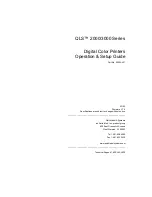
324
UF-9000
APR 2006
Ver. 3.0
DP-180/190
9.9. POP (Post Office Protocol Version 3)
9.9.1.
Introduction
On certain types of smaller nodes in the Internet it is often impractical to maintain a message transport
system (MTS). For example, a workstation may not have sufficient resources (cycles, disk space) in order
to permit a SMTP server and associated local mail delivery system to be kept resident and continuously
running. Similarly, it may be expensive (or impossible) to keep a personal computer interconnected to an
IP-style network for long amounts of time.
The Post Office Protocol - Version 3 (POP3) is intended to permit a workstation to dynamically access a
mail drop on a server host in a useful fashion. Usually, this means that the POP3 protocol is used to allow a
workstation to retrieve mail that the server is holding for it.
For more detail, please refer to URL of http:// www.imc.org/rfc1939
9.9.2.
Basic Operation
Initially, the server host starts the POP3 service by listening on TCP Port No. 110. When a client host
wishes to make use of the service, it establishes a TCP connection with the server host. When the
connection is established, the POP3 server sends a greeting. The client and POP3 server then exchange
commands and responses (respectively) until the connection is closed or aborted.
Commands in the POP3 consist of a case-insensitive keyword, possibly followed by one or more
arguments. All commands are terminated by a CRLF pair. Keywords and arguments consist of printable
ASCII characters. Keywords and arguments are each separated by a single SPACE character. Keywords
are three or four characters long. Each argument may be up to 40 characters long.
Responses in the POP3 consist of a status indicator and a keyword possibly followed by additional
information. All responses are terminated by a CRLF pair. Responses may be up to 512 characters long,
including the terminating CRLF. There are currently two status indicators: positive ("+OK") and negative ("-
ERR"). Servers MUST send the "+OK" and "-ERR" in upper case.
Responses to certain commands are multi-line. In these cases, which are clearly indicated below, after
sending the first line of the response and a CRLF, any additional lines are sent, each terminated by a CRLF
pair. When all lines of the response have been sent, a final line is sent, consisting of a termination octet
(decimal code 046, ".") and a CRLF pair. If any line of the multi-line response begins with the termination
octet, the line is "byte-stuffed" by pre-pending the termination octet to that line of the response.
Hence a multi-line response is terminated with the five octets "CRLF.CRLF". When examining a multi-line
response, the client checks to see if the line begins with the termination octet. If so and if octets other than
CRLF follow, the first octet of the line (the termination octet) is stripped away. If so and if CRLF immediately
follows the termination character, then the response from the POP server is ended and the line containing
".CRLF" is not considered part of the multi-line response.
A POP3 session progresses through a number of states during its lifetime. Once the TCP connection has
been opened and the POP3 @server has sent the greeting, the session enters the AUTHORIZATION state.
In this state, the client must identify itself to the POP3 server. Once the client has successfully done this, the
server @acquires resources associated with the client’s mail drop, and the session enters the
TRANSACTION state. In this state, the client requests actions on the part of the POP3 server. When the
client has issued the QUIT command, the session enters the UPDATE state. In this state, the POP3 server
releases any resources acquired during @the TRANSACTION state and says goodbye. The TCP
connection is then closed.
A server MUST @respond to an unrecognized, unimplemented, or @syntactically invalid command by
responding with a negative status @indicator. A server MUST respond to a command issued when the
session is in an incorrect state by responding with a negative status indicator. There is no general method
for a client to distinguish between a server which does not implement an optional command and a server
which is unwilling or unable to process the command.
Summary of Contents for DP-180
Page 50: ...50 UF 9000 APR 2006 Ver 3 0 DP 180 190 21 Remove the LCD Module 127 ...
Page 74: ...74 UF 9000 APR 2006 Ver 3 0 DP 180 190 3 3 Preventive Maintenance Points ...
Page 126: ...126 UF 9000 APR 2006 Ver 3 0 DP 180 190 Sensor and Switch Location ...
Page 341: ...341 UF 9000 APR 2006 Ver 3 0 DP 180 190 memo ...
Page 343: ...343 APR 2006 Ver 3 0 UF 9000 DP 180 190 memo ...
Page 359: ...Published in Japan ...
Page 375: ...Published in Japan ...
















































